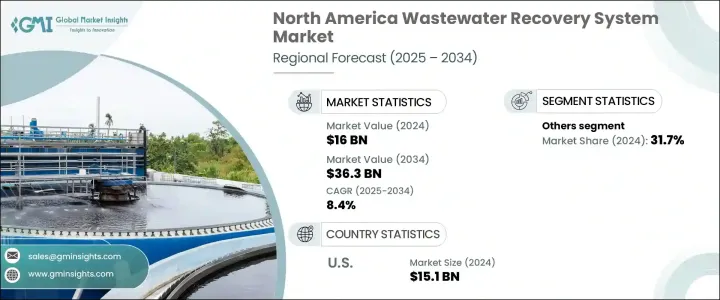PUBLISHER: Global Market Insights Inc. | PRODUCT CODE: 1766332

PUBLISHER: Global Market Insights Inc. | PRODUCT CODE: 1766332
North America Wastewater Recovery System Market Opportunity, Growth Drivers, Industry Trend Analysis, and Forecast 2025 - 2034
North America Wastewater Recovery System Market was valued at USD 16 billion in 2024 and is estimated to reach 8.4% to reach USD 36.3 billion by 2034. The expansion of this market is largely influenced by a wave of regulatory policies, infrastructure upgrades, and increasing environmental consciousness. As water scarcity and contamination concerns escalate, both federal and state governments are accelerating investments aimed at enhancing water recovery capabilities. These efforts are driven by sustainability goals and reinforced by strict regulations that push industries to adopt efficient and compliant wastewater treatment technologies.

National policies are encouraging the reuse and recycling of treated wastewater, making recovery systems a critical part of industrial infrastructure. As regulations grow stricter, manufacturers and service providers are seeing higher demand for advanced, high-performance treatment solutions that ensure environmental compliance while remaining economically viable. With mounting pressure to cut pollution and reuse water resources, the integration of modern recovery technologies into industrial processes is becoming a strategic imperative for many sectors, especially as older systems become insufficient.
| Market Scope | |
|---|---|
| Start Year | 2024 |
| Forecast Year | 2025-2034 |
| Start Value | $16 Billion |
| Forecast Value | $36.3 Billion |
| CAGR | 8.4% |
In the U.S., federal and state programs are channeling funds into wastewater management, creating significant growth opportunities. The Clean Water State Revolving Fund (CWSRF), a state-federal initiative, offers low-interest loans and grants to municipalities for wastewater infrastructure upgrades. Increased spending at the state level is being directed toward the construction of modern treatment plants tailored to local environmental and water supply challenges.
Technologies like reverse osmosis, membrane filtration, ultrafiltration, nanofiltration, and microfiltration are key to the advanced treatment of wastewater. The membrane filtration segment is expected to grow at a notable CAGR through 2034, as techniques are crucial for removing pathogens, dissolved solids, and other impurities from effluent, producing high-quality water suitable for reuse in a wide range of applications. Their effectiveness in removing contaminants makes them central to the design of wastewater recovery systems aimed at meeting environmental standards.
In North America oil & gas segment is expected to grow at a decent CAGR through 2034, particularly in areas with intensive drilling operations, produced water from hydraulic fracturing is creating significant environmental and operational challenges. Traditional disposal methods, such as deep well injection, are being reevaluated due to concerns like induced seismic activity. As a result, energy companies are increasingly turning to innovative water recovery technologies to treat and reuse this wastewater, reducing disposal-related risks and conserving freshwater resources for other uses.
U.S. Wastewater Recovery System Market generated USD 15.1 billion in 2024. Growth in this market is largely supported by a well-established network of solution providers and favorable policies promoting environmentally responsible practices. The U.S., alongside Canada, is at the forefront of wastewater recovery in the region, backed by stringent enforcement of environmental laws such as the Clean Water Act. This framework requires industries to meet high discharge standards, motivating the adoption of systems like membrane filtration and advanced oxidation processes.
Among the key players leading the North America Wastewater Recovery System Market are Veolia, Kemco Systems, Calgon Carbon Corporation, Pall Corporation, and Evoqua Water Technologies LLC. To solidify their position in the competitive landscape, companies in the North America wastewater recovery system market are adopting forward-thinking strategies. They are heavily investing in R&D to develop cutting-edge and energy-efficient treatment technologies. Strategic collaborations and partnerships are being used to expand service portfolios and enter new regional markets. Companies are also integrating smart monitoring systems to improve operational efficiency and compliance tracking.
Table of Contents
Chapter 1 Methodology & Scope
- 1.1 Market scope & definitions
- 1.2 Market estimates & forecast parameters
- 1.3 Forecast calculation
- 1.4 Data sources
- 1.4.1 Primary
- 1.4.2 Secondary
- 1.4.2.1 Paid
- 1.4.2.2 Public
Chapter 2 Industry Insights
- 2.1 Industry ecosystem analysis
- 2.2 Regulatory landscape
- 2.3 Industry impact forces
- 2.3.1 Growth drivers
- 2.3.2 Industry pitfalls & challenges
- 2.4 Growth potential analysis
- 2.5 Porter's analysis
- 2.5.1 Bargaining power of suppliers
- 2.5.2 Bargaining power of buyers
- 2.5.3 Threat of new entrants
- 2.5.4 Threat of substitutes
- 2.6 PESTEL analysis
Chapter 3 Competitive Landscape, 2025
- 3.1 Introduction
- 3.2 Company market share analysis, 2024
- 3.3 Strategic dashboard
- 3.4 Strategic initiatives
- 3.5 Competitive benchmarking
- 3.6 Innovation & technology landscape
Chapter 4 Market Size and Forecast, By Technology, 2021 - 2034 (USD Billion)
- 4.1 Key trends
- 4.2 Activated carbon
- 4.3 Ultra-filtration & reverse osmosis
- 4.4 Membrane filtration
- 4.5 Ion exchange resin systems
- 4.6 Media filtration
- 4.7 Others
Chapter 5 Market Size and Forecast, By Application, 2021 - 2034 (USD Billion)
- 5.1 Key trends
- 5.2 Pharmaceuticals
- 5.3 Oil & gas
- 5.4 Metal mining
- 5.5 Chemical
- 5.6 Food & beverages
- 5.7 Others
Chapter 6 Market Size and Forecast, By country, 2021 - 2034 (USD Billion)
- 6.1 Key trends
- 6.2 U.S.
- 6.3 Canada
Chapter 7 Company Profiles
- 7.1 Aquatech
- 7.2 ARIES CLEAN TECHNOLOGIES
- 7.3 BioChem Technology
- 7.4 BIOREM
- 7.5 Calgon Carbon Corporation
- 7.6 CLEARAS Water Recovery
- 7.7 ClearBlu Environmental
- 7.8 DYNATEC SYSTEMS, INC.
- 7.9 ENCON Evaporators
- 7.10 Evoqua Water Technologies LLC
- 7.11 H2O Innovation
- 7.12 Huber Technology Inc.
- 7.13 Kemco Systems
- 7.14 Koch Separation Solutions
- 7.15 KONTEK ECOLOGY SYSTEMS INC.
- 7.16 Mech-Chem Associates, Inc.
- 7.17 Newterra
- 7.18 Pall Corporation
- 7.19 Saltworks Technologies Inc.
- 7.20 Veolia




